The mast reach truck market is valued at USD 2.0 billion in 2025 and is projected to reach USD 2.9 billion by 2035, expanding at a CAGR of 3.8%. Regional dynamics indicate that warehouse modernization levels, e-commerce expansion, and industrial growth rates shape adoption patterns. North America is set to retain a leading role, supported by high penetration of automated warehouse systems in the United States and Canada, coupled with strong investment in logistics infrastructure. The shift toward high-density storage solutions and the integration of mast reach trucks with warehouse management systems will accelerate adoption. Europe follows with steady growth, driven by regulatory frameworks promoting warehouse safety and the widespread adoption of advanced material handling equipment across Germany, France, and the UK. The emphasis on energy-efficient and electric reach trucks is particularly strong in this region.
Asia-Pacific is forecast to experience the fastest expansion, supported by rising e-commerce penetration, aggressive warehouse construction, and the growing adoption of automation across China, India, and Southeast Asia. Manufacturers in the region are investing heavily in affordable yet high-performance reach trucks to serve both domestic and export markets. The integration of AI-enabled fleet management systems with reach trucks is also expanding in advanced economies such as Japan and South Korea. Meanwhile, regions such as Latin America, the Middle East, and Africa will contribute steadily, though at a smaller scale, with adoption driven by logistics upgrades and selective deployment of advanced reach trucks in large-scale distribution hubs and port facilities.
Overall, North America continues to dominate due to technological leadership and infrastructure readiness; Europe strengthens its presence through compliance-driven modernization; and Asia-Pacific leads in growth rates driven by large-scale e-commerce demand and rapid industrialization. Other regions represent niche but emerging opportunities tied to urban logistics and regional trade expansion from 2025 to 2035.
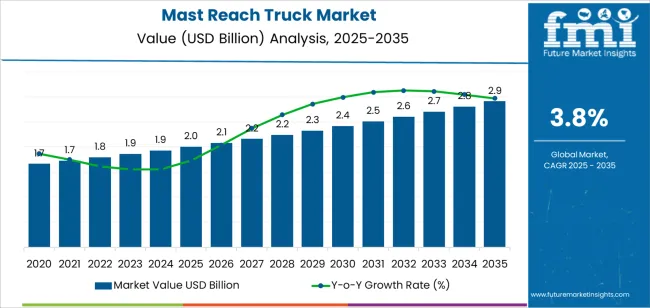
| Period | Primary Revenue Buckets | Share | Notes |
|---|---|---|---|
| Today | Two-stage mast reach trucks | 62% | Standard warehouse operations, established facilities |
| Single-stage mast systems | 28% | Compact operations, limited height applications | |
| Advanced multi-stage systems | 10% | High-rise warehouses, specialized applications | |
| Future (3-5 yrs) | Advanced two-stage systems | 52-55% | Enhanced lifting capacity, smart controls |
| High-rise multi-stage masts | 22-25% | Automated warehouses, vertical storage | |
| Port & terminal operations | 15-18% | Container handling, intermodal facilities | |
| E-commerce fulfillment | 8-12% | Distribution centers, order picking | |
| Cold storage applications | 6-9% | Temperature-controlled facilities | |
| Custom & specialty systems | 3-6% | Specialized industries, unique requirements |
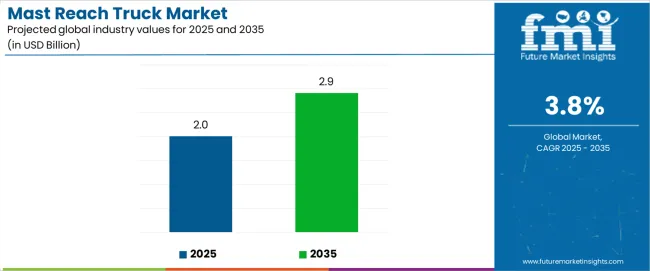
At-a-Glance Metrics
| Metric | Value |
|---|---|
| Market Value (2025) | USD 2.0 billion |
| Market Forecast (2035) | USD 2.9 billion |
| Growth Rate | 3.8% CAGR |
| Leading Mast Type | Two-Stage Mast Systems |
| Primary Application | High-Rise Warehousing Segment |
The mast reach truck market demonstrates strong fundamentals with two-stage mast systems capturing a dominant share through advanced lifting technologies and warehouse operation optimization. High-rise warehousing applications drive primary demand, supported by increasing storage density requirements and logistics industry modernization initiatives. Geographic expansion remains concentrated in developed markets with established warehouse infrastructure, while emerging economies show accelerating adoption rates driven by e-commerce growth and rising automation standards.
Design for operational efficiency, not just lifting capacity
Warehouse automation readiness
Performance-by-design approach
Value-based service models
Primary Classification: The mast reach truck market segments by mast type into single-stage, two-stage, and others, representing the evolution from basic lifting solutions to sophisticated multi-stage systems for comprehensive warehouse storage optimization.
Secondary Classification: Application segmentation divides the mast reach truck market into high-rise warehousing, port operations, and others, reflecting distinct requirements for lifting performance, storage density, and operational efficiency specifications.
Tertiary Classification: End-use segmentation covers distribution centers, manufacturing facilities, retail chains, automotive plants, and logistics providers, while distribution channels span direct sales, equipment dealers, and specialized material handling distributors.
Regional Classification: Geographic distribution covers North America, Latin America, Western Europe, Eastern Europe, East Asia, South Asia Pacific, and Middle East & Africa, with developed markets leading adoption while emerging economies show accelerating growth patterns driven by warehouse modernization programs.
The segmentation structure reveals mast progression from traditional single-stage systems toward sophisticated multi-stage configurations with enhanced performance capabilities, while application diversity spans from high-density warehouses to specialized port operations requiring precision material handling solutions.
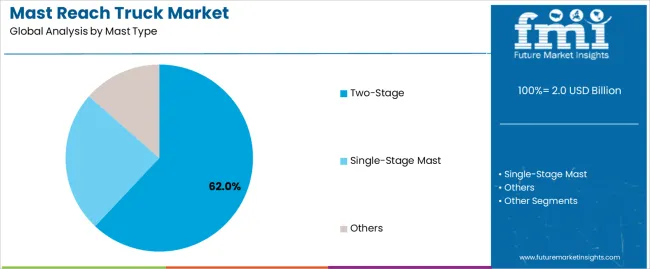
Market Position: Two-stage mast systems command the leading position in the mast reach truck market with 62% market share through proven lifting technologies, including enhanced height capabilities, load stability optimization, and operational versatility that enable warehouse operators to achieve optimal storage density across diverse distribution and manufacturing environments.
Value Drivers: The segment benefits from warehouse industry preference for versatile mast systems that provide optimal height reach, load handling capacity, and operational flexibility without requiring specialized infrastructure. Advanced two-stage engineering features enable enhanced stability control, precise positioning, and integration with existing warehouse management systems, where lifting performance and operational reliability represent critical operational requirements.
Competitive Advantages: Two-stage mast systems differentiate through proven lifting reliability, operational versatility, and integration with established warehouse management platforms that enhance facility productivity while maintaining optimal safety standards suitable for diverse material handling applications.
Key market characteristics:
Single-stage mast systems maintain a 28% market position in the mast reach truck market due to their compact advantages and cost-effective positioning benefits. These systems appeal to facilities requiring efficient material handling solutions with moderate height requirements for smaller warehouse operations. Market growth is driven by small-to-medium warehouse expansion, emphasizing operational simplicity and cost efficiency through optimized compact designs.
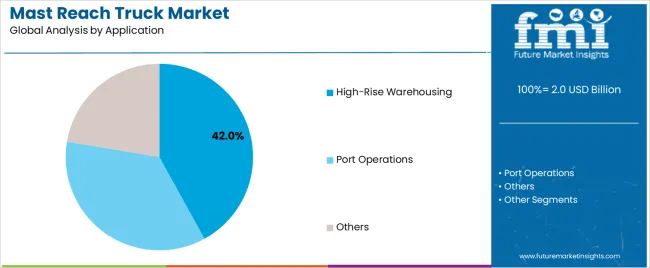
Market Context: High-rise warehousing applications demonstrate strong growth in the mast reach truck market with 42% share, due to widespread adoption of vertical storage systems and increasing focus on storage density optimization, operational cost efficiency, and space utilization applications that maximize warehouse effectiveness while maintaining safety standards.
Appeal Factors: Warehouse operators prioritize equipment reliability, storage density optimization, and integration with existing logistics infrastructure that enables coordinated material handling operations across multiple storage levels. The segment benefits from substantial logistics industry investment and automation programs that emphasize the acquisition of advanced reach trucks for storage optimization and operational efficiency applications.
Growth Drivers: Warehouse expansion programs incorporate mast reach trucks as essential components for high-density storage, while e-commerce growth increases demand for equipment capabilities that comply with throughput requirements and minimize operational complexity.
Market Challenges: Varying warehouse configurations and operational scale complexity may limit equipment standardization across different facilities or storage scenarios.
Application dynamics include:
Port operations applications capture 32% market share through specialized handling requirements in container terminals, intermodal facilities, and cargo applications. These facilities demand specialized reach trucks capable of supporting heavy-duty operations while providing precise positioning access and operational durability capabilities.
Manufacturing Applications Show Industrial Growth
Manufacturing applications account for 26% market share, including production facilities, assembly plants, and industrial operations requiring versatile material handling capabilities for inventory management and operational effectiveness.
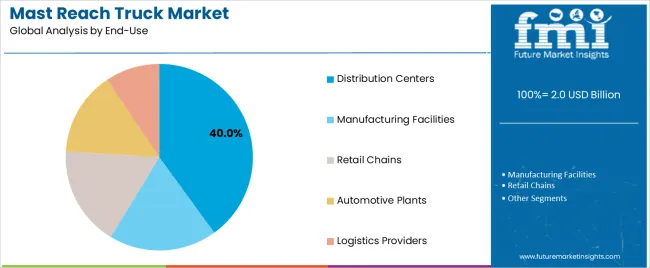
Market Context: Distribution Centers dominate the mast reach truck market with a 40% share, reflecting the primary demand source for mast reach truck technology in logistics applications and warehouse automation.
Business Model Advantages: Distribution Centers provide direct market demand for efficient material handling systems, driving volume production and operational optimization while maintaining productivity standards and safety requirements.
Operational Benefits: Distribution Center applications include inventory optimization, throughput efficiency, and safety assurance that drive consistent demand for reach truck systems while providing access to latest warehouse technologies.
| Category | Factor | Impact | Why It Matters |
|---|---|---|---|
| Driver | E-commerce growth & warehouse expansion (online retail, fulfillment centers) | ★★★★★ | Growing logistics market requires efficient material handling with enhanced storage density capabilities and operational reliability proven effective across warehouse applications. |
| Driver | Warehouse automation advancement & productivity requirements (WMS integration, fleet optimization) | ★★★★★ | Transforms equipment requirements from "basic lifting" to "intelligent material handling"; operators that offer automated features and integration capabilities gain competitive advantage. |
| Driver | High-density storage demand & space optimization (vertical storage, inventory density) | ★★★★☆ | Modern warehouses need space-efficient solutions; demand for advanced reach trucks with superior lifting capabilities expanding addressable market. |
| Restraint | High capital costs & equipment investment (especially for advanced systems) | ★★★★☆ | Smaller warehouse operators defer equipment upgrades; increases price sensitivity and slows advanced technology adoption in cost-conscious markets. |
| Restraint | Alternative handling solutions competition (conventional forklifts, automated systems) | ★★★☆☆ | Standard forklift alternatives offer established supply chains and lower costs, potentially limiting reach truck adoption in traditional applications. |
| Trend | Technology integration & smart features (IoT connectivity, predictive maintenance) | ★★★★★ | Advanced control systems, performance monitoring, and predictive analytics transform operations; technology integration and automation become core value propositions. |
| Trend | Customization & application-specific solutions (industry adaptation, specialized configurations) | ★★★★☆ | Custom equipment for specific industries and applications; specialized designs and targeted solutions drive competition toward customization capabilities. |
The mast reach truck market demonstrates varied regional dynamics with Growth Leaders including China (5.1% growth rate) and India (4.8% growth rate) driving expansion through warehouse development initiatives and logistics industry modernization. Steady Performers encompass Germany (4.4% growth rate), Brazil (4.0% growth rate), and developed regions, benefiting from established logistics industries and material handling adoption. Mature Markets feature United States (3.6% growth rate), United Kingdom (3.2% growth rate), and Japan (2.9% growth rate), where warehouse advancement and automation requirements support consistent growth patterns.
Regional synthesis reveals East Asian markets leading adoption through logistics expansion and warehouse development, while North American countries maintain steady expansion supported by equipment technology advancement and operational optimization requirements. European markets show strong growth driven by warehouse applications and automation integration trends.
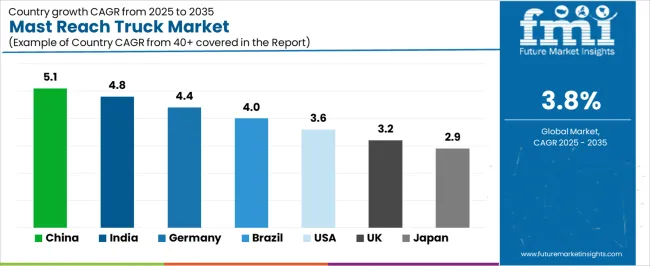
| Region/Country | 2025 to 2035 Growth | How to win | What to watch out |
|---|---|---|---|
| China | 5.1% | Focus on high-volume manufacturing solutions | Regulatory changes; local competition |
| India | 4.8% | Lead with cost-effective warehouse solutions | Import restrictions; infrastructure barriers |
| Germany | 4.4% | Provide premium automation equipment | Over-regulation; lengthy approvals |
| Brazil | 4.0% | Offer value-oriented logistics solutions | Currency fluctuations; import duties |
| United States | 3.6% | Push technology integration | Compliance costs; scaling challenges |
| United Kingdom | 3.2% | Focus on premium warehouse applications | Economic impacts; equipment costs |
| Japan | 2.9% | Emphasize precision manufacturing | Traditional preferences; adoption rates |
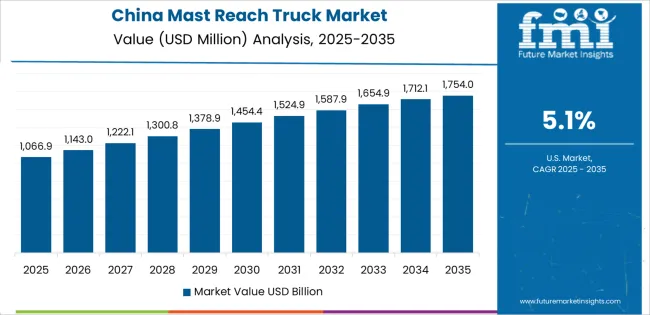
China establishes fastest market growth through aggressive warehouse development programs and comprehensive logistics industry expansion, integrating advanced mast reach truck systems as standard components in distribution facilities and manufacturing installations. The country's 5.1% growth rate reflects government initiatives promoting logistics infrastructure and domestic material handling capabilities that mandate the use of efficient equipment systems in warehouse and manufacturing facilities.
Growth concentrates in major logistics hubs, including Shanghai, Shenzhen, and Tianjin, where warehouse development showcases integrated reach truck systems that appeal to logistics operators seeking storage optimization capabilities and operational applications.
Chinese manufacturers are developing cost-effective material handling solutions that combine domestic production advantages with advanced mast features, including enhanced lifting control and improved stability capabilities. Distribution channels through equipment dealers and logistics suppliers expand market access, while government support for warehouse development supports adoption across diverse manufacturing and distribution segments.
Strategic Market Indicators:
In Mumbai, Delhi, and Chennai, warehouse facilities and distribution operators are implementing advanced mast reach truck systems as standard equipment for storage optimization and operational efficiency applications, driven by increasing government logistics investment and manufacturing modernization programs that emphasize the importance of material handling capabilities.
The mast reach truck market holds a 4.8% growth rate, supported by government logistics initiatives and industrial development programs that promote efficient equipment systems for warehouse and manufacturing facilities. Indian operators are adopting reach truck systems that provide consistent lifting performance and operational features, particularly appealing in urban regions where storage density and operational efficiency represent critical business requirements.
Market expansion benefits from growing logistics capabilities and international trade partnerships that enable domestic production of material handling systems for warehouse and distribution applications. Technology adoption follows patterns established in warehouse equipment, where reliability and performance drive procurement decisions and operational deployment.
Market Intelligence Brief:
Advanced logistics market in Germany demonstrates sophisticated mast reach truck deployment with documented operational effectiveness in warehouse applications and distribution facilities through integration with existing logistics systems and operational infrastructure. The country leverages engineering expertise in material handling and automation systems integration to maintain a 4.4% growth rate. Logistics centers, including North Rhine-Westphalia, Bavaria, and Baden-Württemberg, showcase premium installations where reach truck systems integrate with comprehensive warehouse platforms and facility management systems to optimize storage density and operational effectiveness.
German manufacturers prioritize system quality and EU compliance in equipment development, creating demand for premium systems with advanced features, including facility integration and automation capabilities. The mast reach truck market benefits from established logistics infrastructure and a willingness to invest in advanced material handling technologies that provide long-term operational benefits and compliance with international logistics standards.
Market Intelligence Brief:
Mast reach truck marketexpansion in Brazil benefits from diverse logistics demand, including manufacturing modernization in São Paulo and Rio de Janeiro, warehouse facility upgrades, and government industrial programs that increasingly incorporate material handling solutions for operational applications. The country maintains a 4.0% growth rate, driven by rising industrial activity and increasing recognition of reach truck benefits, including precise storage control and enhanced operational effectiveness.
Market dynamics focus on cost-effective equipment solutions that balance operational performance with affordability considerations important to Brazilian logistics operators. Growing industrialization creates continued demand for modern material handling systems in new warehouse infrastructure and facility modernization projects.
Strategic Market Considerations:
United States establishes market leadership through comprehensive logistics programs and advanced warehouse infrastructure development, integrating mast reach truck systems across distribution and manufacturing applications. The country's 3.6% growth rate reflects established logistics industry relationships and mature equipment technology adoption that supports widespread use of reach truck systems in warehouse and distribution facilities. Growth concentrates in major logistics centers, including California, Texas, and Illinois, where material handling technology showcases mature deployment that appeals to warehouse operators seeking proven storage capabilities and operational efficiency applications.
American logistics providers leverage established distribution networks and comprehensive technical support capabilities, including training programs and service support that create customer relationships and operational advantages. The mast reach truck market benefits from mature safety standards and warehouse requirements that mandate equipment system use while supporting technology advancement and operational optimization.
Market Intelligence Brief:
United Kingdom's logistics market demonstrates integrated mast reach truck deployment with documented operational effectiveness in warehouse applications and distribution facilities through integration with existing logistics systems and operational infrastructure. The country maintains a 3.2% growth rate, supported by operational efficiency programs and storage effectiveness requirements that promote reach truck systems for warehouse applications. Distribution facilities across England, Scotland, and Wales showcase systematic installations where reach truck systems integrate with comprehensive logistics platforms to optimize storage density and operational outcomes.
UK logistics providers prioritize system reliability and industry compatibility in equipment procurement, creating demand for validated systems with proven performance features, including automation integration and safety systems. The mast reach truck market benefits from established warehouse infrastructure and efficiency requirements that support material handling technology adoption and operational effectiveness.
Market Intelligence Brief:
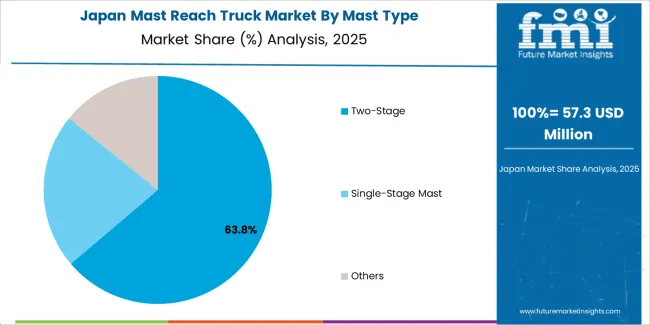
Mast reach truck marketgrowth in Japan benefits from precision logistics demand, including advanced manufacturing facilities in Tokyo and Osaka, quality integration, and operational enhancement programs that increasingly incorporate material handling solutions for precision applications. The country maintains a 2.9% growth rate, driven by manufacturing technology advancement and increasing recognition of precision equipment benefits, including accurate positioning control and enhanced operational outcomes.
Market dynamics focus on high-precision material handling solutions that meet Japanese quality standards and operational effectiveness requirements important to manufacturing operators. Advanced manufacturing technology adoption creates continued demand for sophisticated reach truck systems in facility infrastructure and operational modernization projects.
Strategic Market Considerations:
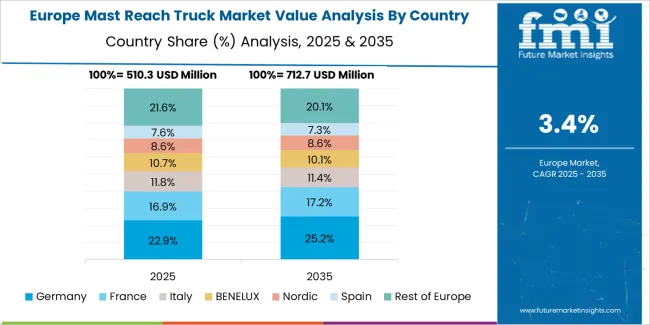
The European mast reach truck market is projected to grow from USD 442.6 million in 2025 to USD 643.2 million by 2035, registering a CAGR of 3.8% over the forecast period. Germany is expected to maintain its leadership position with a 41.3% market share in 2025, supported by its advanced manufacturing infrastructure and major logistics centers.
United Kingdom follows with a 22.8% share in 2025, driven by comprehensive warehouse programs and logistics excellence development initiatives. France holds a 16.2% share through specialized industrial applications and automation compliance requirements. Italy commands a 11.7% share, while Spain accounts for 8.0% in 2025. The rest of Europe region is anticipated to gain momentum, expanding its collective share from 4.1% to 4.8% by 2035, attributed to increasing warehouse adoption in Nordic countries and emerging logistics facilities implementing automation modernization programs.
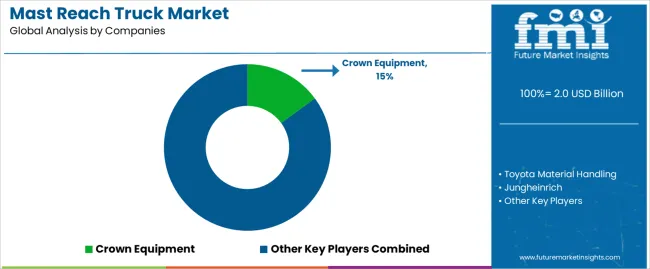
| Stakeholder | What they actually control | Typical strengths | Typical blind spots |
|---|---|---|---|
| Global brands | Distribution reach, comprehensive product catalogs, brand recognition | Wide availability, proven reliability, multi-region support | Product refresh cycles; customer dependency on brand validation |
| Technology innovators | Mast R&D; advanced lifting technologies; enhanced automation features | Latest technologies first; attractive ROI on operational effectiveness | Service density outside core regions; scaling complexity |
| Regional specialists | Local compliance, fast delivery, nearby customer support | "Close to customer" support; pragmatic pricing; local regulations | Technology gaps; talent retention in customer service |
| Full-service providers | Equipment programs, maintenance services, fleet management | Lowest operational risk; comprehensive support | Service costs if overpromised; technology obsolescence |
| Niche specialists | Specialized applications, custom equipment, industry services | Win premium applications; flexible configurations | Scalability limitations; narrow market focus |
| Item | Value |
|---|---|
| Quantitative Units | USD 2.0 billion |
| Mast Type | Single-Stage Mast, Two-Stage Mast, Others |
| Application | High-Rise Warehousing, Port Operations, Others |
| End Use | Distribution Centers, Manufacturing Facilities, Retail Chains, Automotive Plants, Logistics Providers |
| Regions Covered | North America, Latin America, Western Europe, Eastern Europe, East Asia, South Asia Pacific, Middle East & Africa |
| Countries Covered | China, India, Germany, Brazil, United States, United Kingdom, Japan, Canada, France, Australia, and 25+ additional countries |
| Key Companies Profiled | Crown Equipment, Toyota Material Handling, Jungheinrich, Hyster-Yale, KION Group, Mitsubishi Logisnext, Doosan Bobcat, Manitou, Konecranes |
| Additional Attributes | Dollar sales by mast type and application categories, regional adoption trends across East Asia, North America, and Western Europe, competitive landscape with equipment manufacturers and material handling suppliers, warehouse operator preferences for equipment effectiveness and operational performance, integration with warehouse management systems and fleet optimization platforms, innovations in mast technology and automation enhancement, and development of advanced reach truck solutions with enhanced performance and operational optimization capabilities. |
The global mast reach truck market is estimated to be valued at USD 2.0 billion in 2025.
The market size for the mast reach truck market is projected to reach USD 2.9 billion by 2035.
The mast reach truck market is expected to grow at a 3.8% CAGR between 2025 and 2035.
The key product types in mast reach truck market are two-stage , single-stage mast and others.
In terms of application, high-rise warehousing segment to command 42.0% share in the mast reach truck market in 2025.






Full Research Suite comprises of:
Market outlook & trends analysis
Interviews & case studies
Strategic recommendations
Vendor profiles & capabilities analysis
5-year forecasts
8 regions and 60+ country-level data splits
Market segment data splits
12 months of continuous data updates
DELIVERED AS:
PDF EXCEL ONLINE
Mastectomy Reconstruction Implants Market Size and Share Forecast Outlook 2025 to 2035
Mastic Gum Market Size and Share Forecast Outlook 2025 to 2035
Master Recharge API Market Analysis - Size, Share, & Forecast Outlook 2025 to 2035
Masterbatch Market Size and Share Forecast Outlook 2025 to 2035
Mastic Tapes Market from 2025 to 2035
Mast Cell Tumor Treatment Market Trends – Analysis & Forecast 2024-2034
Master Recharge API in Malaysia – Fintech & Digital Growth
Stigmasterol-Rich Plant Sterols Market Analysis by Source and Application others Through 2035
High Mast Lighting Market Forecast and Outlook 2025 to 2035
Vertical Mast Lifts Market Analysis & Forecast by Product Type, Working Height, Capacity, End-user Industry, and Region Through 2035
Systemic Mastocytosis Treatment Market
Telescopic Masts Market Size and Share Forecast Outlook 2025 to 2035
Healthcare Master Data Management Market Size and Share Forecast Outlook 2025 to 2035
Industry Share Analysis for Telescopic Masts Companies
Flame Retardant Masterbatch Market Size and Share Forecast Outlook 2025 to 2035
Electronic Trial Master File (eTMF) System Market Size and Share Forecast Outlook 2025 to 2035
Oxygen Scavenger Masterbatch Market Size and Share Forecast Outlook 2025 to 2035
Indolent Systemic Mastocytosis treatment Market Insights: Size, Trends & Forecast 2025 to 2035
Automotive Brake Booster and Master Cylinder Market Size and Share Forecast Outlook 2025 to 2035
Reachers Market Size and Share Forecast Outlook 2025 to 2035

Thank you!
You will receive an email from our Business Development Manager. Please be sure to check your SPAM/JUNK folder too.
Chat With
MaRIA